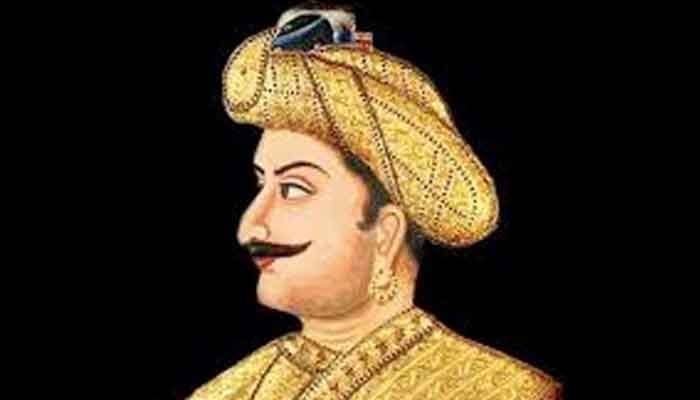All about Tipu Sultan
This is what Imran had stated on February 28 during the course of his crucial speech before both friends and his political adversaries: “We’d heard about the two kings. But our hero is Tipu Sultan, who used to say that a lion’s life for a day is preferable to hundred years of a jackal.”
LAHORE: While announcing a health insurance package for 112,000 families living in Tharparkar on Friday, Prime Minister Imran Khan once again emulated Tipu Sultan, speaking volumes of how much the Pakistani head of government is inspired by sub-continent’s courageous ruler of the 18th century.
It is worth mentioning that just over a week ago, on February 28, 2019, Imran Khan had drawn a comparison between the gallantry of Tipu Sultan (1750-1799) and the cowardice of the last Mughal Emperor, Bahadur Shah Zafar (1775-1862), who had to surrender before the British Empire.
The Pakistani premier had drawn this comparison at the joint sitting of parliament, which was convened in the wake of the ongoing Pak-India tension. This is what Imran had stated on February 28 during the course of his crucial speech before both friends and his political adversaries: “We’d heard about the two kings. But our hero is Tipu Sultan, who used to say that a lion’s life for a day is preferable to hundred years of a jackal.”
Let us peek through the chronicles of history to see and analyze what had actually made Imran Khan compare Tipu Sultan, the Tiger of Mysore, to Mughal King Bahadur Shah Zafar. History reveals that while Mirza Abu Zafar Siraj-ud-din Muhammad Bahadur Shah Zafar had ruled India for 20 years between 1837 and 1857 till his surrender and consequent arrest, Fateh Ali Sahab Tipu or Tipu Sultan’s reign over the Kingdom of Mysore had spanned nearly 17 years between 1782 and 1799.
Both rulers just had one thing in common; they were betrayed by their most trusted cronies. While Tipu’s trust was betrayed by his most loyal army general, Mir Sadiq, Bahadur Shah Zafar had fallen to a few British spies and informers like Hakim Ahsanullah Khan and Mirza Illahi Bux within his ranks.
Tipu, the eldest son of Sultan Hyder Ali and Fatima Fakhr-un-Nisa, is famous in history for his innovations in coinage and for introduction of a new land revenue system that had literally stimulated the growth of Mysore’s silk industry.
Mysore was considered an economic power with high wages and living standards during Tipu’s eventful reign. He was named “Tipu Sultan” after a revered Sufi saint, Hazrat Tipu Mastan Aulia of Arcot, a town in the state of Tamil Nadu, India.
He is considered a pioneer in the use of rockets, during combats with the East India Company. Tipu, an implacable enemy of the British East India Company, had deployed the iron-cased rockets against advances of British forces and their allies during the various Anglo-Mysore wars.
Two of these rockets, with twin sharpened blades mounted on them, captured by the British at Srirangapatna, were later displayed in London’s Royal Artillery Museum. The British had copied the design, updated them and used them in their wars against celebrated French conqueror, Napoleon Bonaparte, who was Tipu’s ally against the British Empire.
Tipu’s Navy consisted of 20 battleships of 72 cannons and 20 frigates of 62 cannons. He had various conflicts with his neighbours and had fought many battles, including the famous Maratha-Mysore War, which had culminated after the inking of an accord.
The treaty had required of Tipu Sultan to pay 4.8 million rupees as a one -time war cost to the Marathas, and an annual tribute of 1.2 million rupees in addition to returning all the territory captured by his father, Hyder Ali.
During the Fourth Anglo-Mysore War, the British forces had joined hands with the Nizam of Hyderabad to defeat Tipu, who was shot and killed in May 1799.
Tipu Sultan’s death is widely attributed to his trusted general Mir Sadiq's betrayal.
According to many historic accounts, Mir Sadiq had pulled out a bigger chunk of the Mysore’s army from the battlefield during the most crucial part of the siege.
The soldiers were ordered to collect their salaries when the battle was at its peak intensity. This weakened the defence of Tipu Sultan and led to a breach in the otherwise highly-fortified Sringapatam Fort.
The news reached Tipu, who was engaged in another front. He rushed to the breached wall, but it was too late.
Since, it was dusk and the sunlight had faded away, the British had dispatched a party of men to search for Tipu’s body in the battlefield.
They were visibly scared and unsure if their most formidable foe was really dead.
Tipu’s body was eventually found in Seringapatam, the capital of Mysore.
Tipu’s opponent army comprised of more than 26,000 soldiers of the British East India Company, some 4,000 Europeans and Indians. In addition, the Nizam of Hyderabad had contributed with 10 battalions and more than 16,000 cavalry. Thus, the soldiers in the British force numbered more than 50,000, whereas Tipu Sultan had only about 30,000.
After the British had broken through the Seringapatam city walls, and French military advisers had told Tipu to live and fight another day by escaping through a secret passage, but he had replied: “It is better to live one day as a tiger, rather than a hundred years as a jackal.”
However, despite all his military and economic heroics, Tipu has been a controversial figure and was criticized for his repression of Hindus and Christians.
Numerous historians like Thomas Paul Hayavadana Rao (The encyclopedic court history of Mysore) have written that non-Muslims were massacred, imprisoned and forced to convert to Islam during Tipu’s rule.
While some say he had ordered circumcision for non-Muslims, besides destroying various churches and temples, asserting he was notorious for his religious intolerance, other writers like B.A. Saletare had vehemently denied these accounts, maintaining that Tipu had not only appointed Hindu officers in his administration, but had also sanctioned endowments for 156 temples.
A lot of accounts suggest that Tipu Sultan’s Treasurer was Krishna Rao, Shamaiya Iyengar, was his Minister for Post and Police, whereas Moolchand and Sujan Rai were his chief agents at the Mughal court.
Given the fact that some historians of yore have inked diverse opinions about Tipu Sultan’s character, the “Jang Group and Geo Television Network” opted to talk to few eminent and widely-quoted local History professors, who have studied and written about the past, and are regarded as authorities on the subject under review.
Dr. Rashid Ahmed Khan, former Professor and Chairman, Department of Political Science, University of the Punjab, has viewed: “Tipu had waged a war against the British Empire with exemplary bravery. He defended his motherland by sacrificing his life. It is not correct to Tipu to Imran Khan in any way because the ground realities were different two centuries ago. Tipu was an undisputed hero of the whole of undivided India, and he remains to be a hero still---even 220 years after his martyrdom. He could have compromised with the British Empire but he preferred to lay down his life to protect his soil. It is a blatant propaganda that Tipu persecuted Non-Muslims of his time in any way. In fact, he had built temples with state money and many Hindu historians acknowledge this fact.”
Prof Rashid added: “In Tipu’s time, the population of Hindus was far larger than that of Muslims. So, it is hilarious to say Tipu Sultan victimized the non-Muslim residents of Mysore. Even today, he is dubbed a hero of the whole of India. Just a few months ago, a Hindu minister in Karnataka state had something against Tipu, but so intense was the public backlash that the state functionary had to take back his words. He is considered a hero of India at state level.”
Prof Dr. Iqbal Chawla, Dean, Faculty of Arts & Humanities and Chairman, Department of History, University of the Punjab, chipped in saying: “Tipu Sultan carried forward the legacy of his father, Hyder Ali. Had his image not been tarnished by certain historians, he would have been a global hero and a warrior, who had fought with the might of the British Empire despite his dismal resources. Many non-Muslim historians have written that there was complete religious freedom during Tipu’s reign. It is disgusting to read all such anti-Tipu accounts because it is not logically possible that he would have persecuted non-Muslims of his time because Hindus were in a great majority at that time.”
Dr. Chawla maintained: “Hindus were part of Tipu’s government machinery and he had gone on to build temples for them. The whole population of Mysore, in particular, had stood at his side while he was taking on the raging bull of the East India Company. Yes, questions can be asked if Tipu actually participated in Hindu festivals personally or not! He was idolized as a lion and we have often read and heard his famous quote about a lion’s one day life. He enjoyed complete public support.”
Celebrated historian, Chairperson of the Human Rights Commission of Pakistan and prominent left-wing journalist, Dr. Mehdi Hassan, has opined: “During Tipu’s rule, there were not many Christians in Mysore, so I cannot comment on whether the followers of Jesus Christ were victimized on religious grounds by him or not, but it is part of history that Hindus had suffered from his wrath. Tipu considered himself a devout Muslim. Historic accounts tell us that he as an extremist Muslim. And this is why Muslims of Indo-Pak subcontinent admire him.”
Having been a news commentator and analyst for Pakistan Television, BBC, Reuters, Voice of America and Deutsche Welle, besides being elected as an office-bearer of Pakistan Federal Union of Journalists five times, Dr. Mehdi Hassan asserted: “Tipu Sultan was an excellent warrior who was ditched by his own loyalists. I can say that religious tolerance and co-existence were missing during his tenure as Mysore’s ruler. He thought he was a good Muslim.”
Renowned political scientist and Chairman of Pakistan Studies at the Punjab University, Dr. Amjad Magsi has held: “Tipu Sultan was a man of great character. He fought against the British Rule with exemplary resilience and perseverance despite his meagre human resource and dismal logistic backing. He could easily have surrendered to the British, as did other state rulers and barons of the time. But instead of vying for Princely perks, Tipu preferred taking on the British in the battlefields. And this would not have been possible had he not been enjoying complete support of his subjects and people. So, I vehemently shun and reject this propaganda that Tipu snatched or usurped religious freedom from his Non-Muslim subjects.”
Dr. Magsi added: “Tipu is regarded as a hero by all Indians and Pakistanis, be it the Muslims or the Hindus. He is considered a State Hero. People like Tipu are seldom born and are a rarity.”
Meanwhile, Bahadur Shah Zafar was exiled to Rangoon (Burma, called Myanmar now) by the British for his involvement in the Indian Rebellion of 1857, when sepoy (soldiers) regiments had seized Delhi, killing at least killed 52 Europeans.
Zafar’s youngest wife, Zeenat Mahal, his previous wives and some remaining members of the family, including his two sons, had accompanied him to Burma on October 7, 1858 in bullock carts escorted by the forces of Lieutenant Ommaney.
The 1857 uprising had started from Meerut and Mutineers entered Delhi from Bridge of Boats on Yamuna and took control of Delhi after proclaiming Zafar as their King and vowed to restore the court of Great Mughals.
This followed by an intense fight between the ruling British and mutineers, which resulted in mass devastation of Delhi and eventual collapse of first Indian struggle of freedom of 1857.
Bahadur Shah was a reluctant rebel. He was already a very old man when the Rebels literally forced him to become their leader.
He was misled by a lot of people. His own Queen was asking him to surrender to the British and end the War.
He had a brilliant military commander called Bakt Khan who was telling him to escape and carry out the resistance rather than surrender but Bahadur Shah foolishly thought British will be merciful to him. He surrendered at Humayun’s Tomb in Delhi.
He was arrested on September 20, 1857 from Humayun’s tomb by the British forces led by Major William Hodson.
The next day Hodson shot his sons Mirza Mughal and Mirza Khizr Sultan, and grandson Mirza Abu Bakar under his own authority.
The severed heads of the princes were brought before him.
Zafar’s trial had lasted for 41 days, had 19 hearings, 21 witnesses were brought to the dock and over a hundred documents in Persian and Urdu, with their English translations, were produced in the court.
(References: William Dalrymple’s book “The Last Mughal: The fall of Delhi, 1857,” Kanika Sharma’s book “A symbol of state power: Use of the Red Fort in Indian political trials,” and a research paper “The rebel Army in 1857: At the vanguard of the War of Independence or a tyranny of arms?”)
The trial was held at Red Fort in Delhi.
Zafar was tried and found guilty for aiding and abetting the mutinies of the troops, for encouraging and assisting diverse persons in waging war against the British Government, for assuming the sovereignty of Hindustan and for causing and being accessory to the murder of the Christians.
The 82-year old Zafar did defend himself, pleading he was helpless before the will of his soldiers (sepoys), but to no avail.
He had stated in his defense that the sepoys had affixed his official seals on empty envelopes fraudulently to implicate him in the mutiny.
Hakim Ahsanullah Khan, Zafar’s most trusted confidant, his Prime Minister and personal physician, had also betrayed him by testifying against him at the trial in return for a pardon for himself. Ahsanaullah had fled Delhi as soon as troubles mounted for the Mughal Emperor.
Hakim Ahsanullah Khan was Mirza Ghalib’s close friend to, as a few of the great Urdu poet’s letters suggest.
In its May 1, 2014 edition, a reputed India newspaper “The Hindu” had written: “In Ballimaran the haveli of Hakim Ahsanullah Khan can still be seen with its old ambience preserved. The hakim was not only the personal doctor of Bahadur Shah Zafar but also his closest adviser.”
The newspaper had further written: “According to Purushottam Salvi’s book, “A Long Drawn War of Freedom”, Nahar Singh tried to persuade Bahadur Shah to take refuge in Ballabhgarh but the emperor refused and was captured at Humayun’s tomb. However, Nahar Singh avenged the death of Zafar’s sons and grandson at the hands of Hodson by killing a large number of firangi soldiers. Eventually Nahar Singh was captured and hanged on his 35th birthday, September 21, 1858.”
Mirza Ilahi Bux, another trusted aide of the Emperor had also betrayed him by informing Major Hudson of his plans and whereabouts.
Mirza Ilahi Bux was the Emperor's father-in-law and was furious with him for the preferential treatment given by the Emperor to Zeenat Mahal - the youngest wife - and her son. Ilahi Bux’s grandson and the Emperor’s heir apparent had been poisoned to death a year before, in which Zeenat Mahal was suspected.
Zafar was a noted Urdu poet himself. His court was home to several prolific Urdu writers and poets including the likes of Mirza Ghalib, Dagh Dehlavi, Momin Khan Momin and Ibrahim Zauq.
-
 Jennifer Aniston, Jim Curtis Face One Major Hurdle In Their Union
Jennifer Aniston, Jim Curtis Face One Major Hurdle In Their Union -
 Restaurant Workers Detained After ICE Agents Dine At Minnesota Eatery
Restaurant Workers Detained After ICE Agents Dine At Minnesota Eatery -
 Kate Middleton Reveals Sport She Would Not Play With Prince George
Kate Middleton Reveals Sport She Would Not Play With Prince George -
 First Poll Since King Charles' Action Against Andrew Reveals Royal Family's Public Standing
First Poll Since King Charles' Action Against Andrew Reveals Royal Family's Public Standing -
 Blake Lively Strengthens Legal Team Ahead Of Justin Baldoni Trial
Blake Lively Strengthens Legal Team Ahead Of Justin Baldoni Trial -
 'Back To School!': Palace Shares Details Of Princess Anne's Latest Engagements
'Back To School!': Palace Shares Details Of Princess Anne's Latest Engagements -
 Paul Mescal Clarifies Acting Break Comment As He Teases Paul McCartney Role
Paul Mescal Clarifies Acting Break Comment As He Teases Paul McCartney Role -
 Kate Middleton's Unexpected Style Of Arrival At Solo Outing Goes Viral
Kate Middleton's Unexpected Style Of Arrival At Solo Outing Goes Viral -
 Why ‘X’ Is Down? Thousands Report Twitter Outage: Here’s What You Can Do
Why ‘X’ Is Down? Thousands Report Twitter Outage: Here’s What You Can Do -
 Florida Man Held After Alleged Nail-scattering On Busy Intersections
Florida Man Held After Alleged Nail-scattering On Busy Intersections -
 Valeria Nicov: Sean Penn's Athletic Girlfriend Raises Eyebrows With Latest Photos
Valeria Nicov: Sean Penn's Athletic Girlfriend Raises Eyebrows With Latest Photos -
 Sharon Stone Lashes Out At Fellow Award Show Attendees After Stealing Accusations
Sharon Stone Lashes Out At Fellow Award Show Attendees After Stealing Accusations -
 Gwyneth Paltrow Reveals Real Reason She Said Yes To 'Marty Supreme'
Gwyneth Paltrow Reveals Real Reason She Said Yes To 'Marty Supreme' -
 King Charles Says He And Queen Camilla Stand With People Of Ukraine
King Charles Says He And Queen Camilla Stand With People Of Ukraine -
 Ben Affleck Argues In Favour Of His Shirtless Scene In 'The Rip'
Ben Affleck Argues In Favour Of His Shirtless Scene In 'The Rip' -
 Mississippi Postal Worker Arrested After Complaints Of Marijuana Odour In Letters
Mississippi Postal Worker Arrested After Complaints Of Marijuana Odour In Letters




